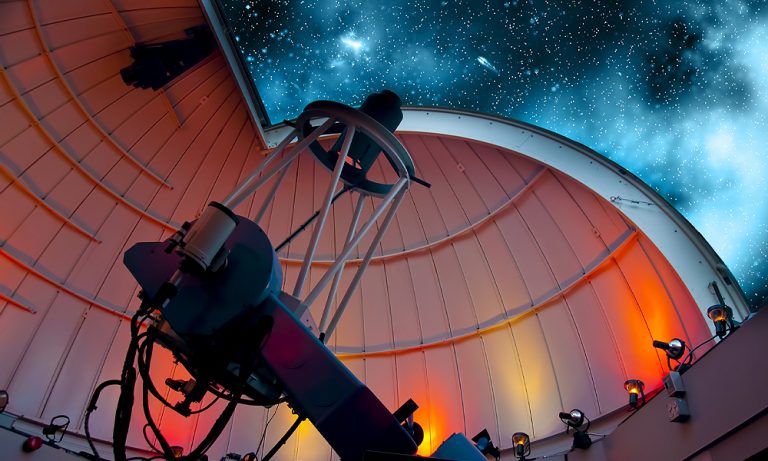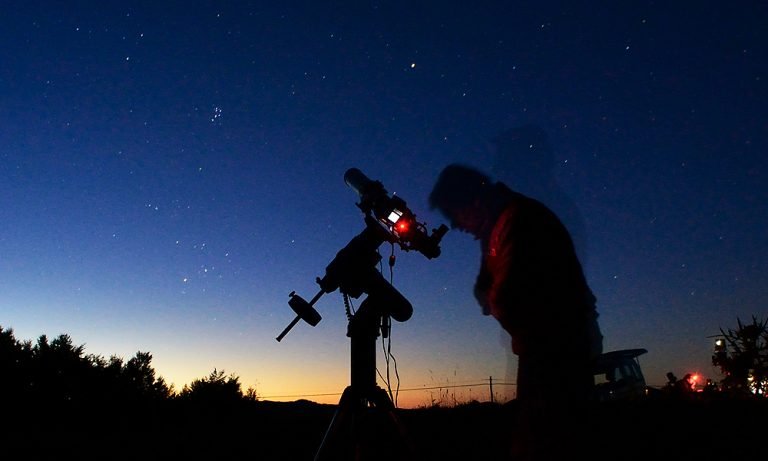12 Best Reflector Telescopes Actually Worth the Money (2024)
A good reflector telescope is the amateur astronomer’s “weapon of choice” and offers the most value for money for visual observation.
The key is a large aperture, so pick the largest you can afford.
The best reflector telescope has a large aperture, is easy to use, and is reasonably portable.
Best Reflector Telescope
1. Orion SkyQuest XT8 Classic Dobsonian Reflector Telescope
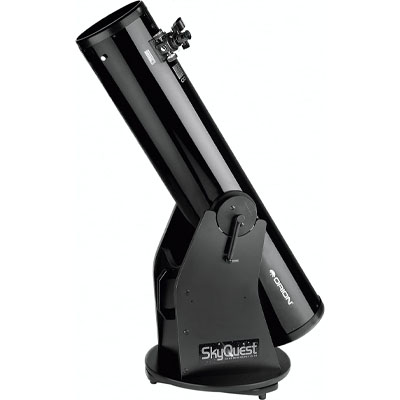
The Orion SkyQuest XT8 Classic is a large reflector telescope that offers the most value for money.
It comes with a big 8” parabolic primary mirror that collects 78% more light than a 6″ mirror, so you get a significant increase in the ability to see details when observing.
It gave us fantastic images of faint deep-sky objects such as nebulas and galaxies.
This best 8 inch reflector telescope is larger than any of the previous scopes we reviewed. It is made of low thermal expansion borosilicate glass for exceptional crisp views.
The Orion reflector comes with two Sirius Plossl 1,25” eyepieces – a 25.0mm and a 10.0mm with 48x and 120x magnification.
The Dobsonian reflector telescope has a base that kept the scope perfectly balanced. We did struggle a bit with the assembly but found a great helping video. We could even try our hand at some astro-imaging and get exciting Moon shots.
What we liked
- A gold standard 8 inch reflector telescope for awe-inspiring views
- Large 1219mm focal length
- 2 Sirius Plossl eyepieces, a 25mm and a 10mm
- Precise Crayford focuser
- Simple and easy to use
What we didn’t like
- On the bulkier side
Type: Dobsonian Reflector Telescope
Aperture: 8” (205mm)
Focal length: 1219mm
Focal ratio: f/5.9
Mount type: Dobsonian
Weight: 39.1 lbs (fully assembled)
What’s special about it: Large 8” eyepiece, great value for money
Best for: Beginner to intermediate
2. Sky Watcher 12″ Collapsible Dobsonian Telescope
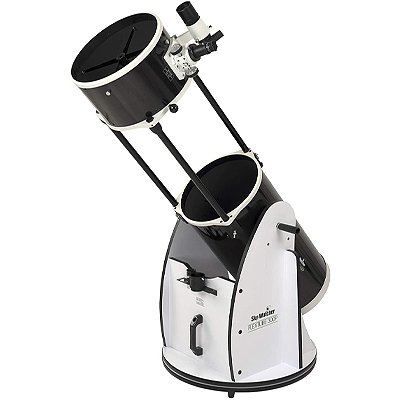
The Sky Watcher Flextube 300 12-inch scope is almost the same quality as the 8-inch Sky-Watcher version.
This one has a larger aperture, longer focal length, a lot better dual-speed focuser, and almost the same weight, which is a good thing for portability.
The same two eyepieces are coming with this scope as well, so please buy at least the cheap aspherical eyepieces.
For backyard astronomy, its bulky rocker base won’t be an issue, but if you ask me, I would drag any kind of 12” to everywhere.
One UHC filter for a start will help a lot, not just for light pollution, but for more contrast as well. Its larger aperture and longer focal length can utilize the best eyepieces out there. In order to experience the full potential of this 12-inch scope, maybe you should buy at least one high-end eyepiece with an ultra-wide apparent field of view at 100°.
The viewfinder is great, but a red dot sight is highly recommended for the Dobsonians. Because of its 12” aperture, for observing the Moon and Moon’s crater, you’ll need an ND-16 filter or a variable ND filter that is an even better choice.
What we liked
- 12” aperture
- Serious DSO hunter
- High contrast
- Large focal length
- Collapsible tube
- Well two-speed fine-tuning focuser
- Great performance
- Nice 8×50 viewfinder
- Easy collimation
What we didn’t like
- Very bulky rocker base
- Both eyepieces are low quality
- Bulky to transport
Type: Collapsible Dobsonian reflecting telescope
Aperture: 12”
Focal length: 1500 mm
Focal ratio: f/5
Limiting stellar magnitude: 14.9
Weight: 58 lbs. (27 kg)
What’s special about it: Great for advanced users, semi-compact, very powerful telescope.
3. Orion SpaceProbe 130ST Equatorial Reflector Telescope
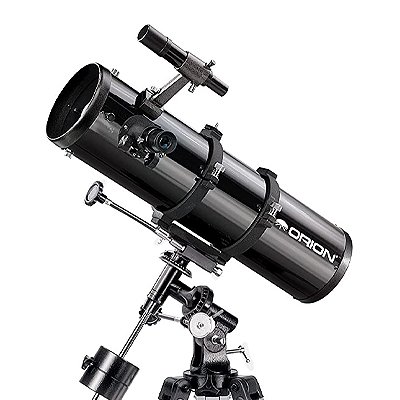
When we set off on vacation, we looked for a telescope that was easy to transport and the Orion SpaceProbe 130ST was one of the best reflectors.
It has a short 24” optical tube, making it easy to fit into the car.
This Newtonian reflector telescope features a 5.1″ aperture, which gathers large amounts of light.
We had great views of the Moon and planets, as well as brighter galaxies and remote star clusters.
The Orion Spaceprobe 130st is a versatile scope that the whole family enjoyed. It comes with a sturdy EQ-2 equatorial mount that is easy to set up.
The adjustable tripod allows manual slow-motion tracking, keeping the image in the eyepiece as it moves across the sky.
The telescope comes with two 1.25” Sirius Plossl eyepieces, 25mm and 10mm. It also has a 6×30 finder scope, collimation cap, a handy tripod accessory tray, and a bonus – Starry Night astronomy software.
What we liked
- Well priced
- 5.1” aperture for bright views
- 2 1.25” Sirius Plossl eyepieces, 25mm and 10mm.
- Great for viewing the Moon, planets and star clusters
- Short length 24” optical tube, great for portability
- Slow-motion controls for ease of use
- Accessory tray, 6×30 finder scope, Starry Night Astronomy Software
What we didn’t like
- Not motorized
- Read the manual carefully if you are a beginner
- The mount gear tends to get sticky from time to time
Type: Newtonian Reflector
Aperture: 5.1” (130mm)
Focal length: 650mm
Focal ratio: f/5
Mount type: Equatorial
Weight: 24.2 lbs. (11kg)
What’s special about it: Easy to transport, 2 eye-pieces
Best for: Beginners to intermediates, great family hobby
4. Orion 8944 SkyQuest XT6 Classic Dobsonian Telescope
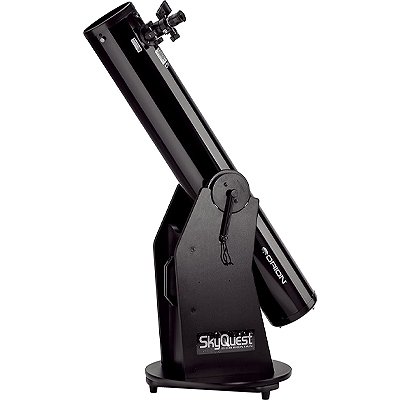
Orion SkyQuest XT6 offers the best bang for your buck. If you are looking for a telescope for visual observation of the night sky, you don’t want to break the budget, and you are not sure if you are into this magnificent hobby.
Then start right here, this is the best reflector telescope for beginners.
I’m sure you’ll be amazed at the quality of the view of the planets and the Moon, plus you can start your deep-sky career with several dozen of the most popular DSOs.
At this price point, you’ll never find a better one. And remember, when you buy a 12” or 16” you can still use this one for planets, and largest and brightest deep-sky objects.
What we liked
- Unbeatable price
- Amazing beginner’s telescope
- Very easy assembling
- Excellent focal length
- Sharp view
- Very good for the Moon and planets
- Use it as a secondary scope
What we didn’t like
- No dual-speed focuser
- Very bulky tube and mount
- 20 mm Plossl eyepiece
- Hard panning and tilting
- Eyepiece position at low altitude objects
Type: Dobsonian reflecting telescope
Aperture: 6”
Focal length: 1200 mm
Focal ratio: f/8
Limiting stellar magnitude: 13.5
Weight: 34.4 lbs. (15.8 kg)
What’s special about it: Amazing beginners, an unbeatable price even for occasional usage.
5. Celestron NexStar 130 SLT Computerized Reflector Telescope
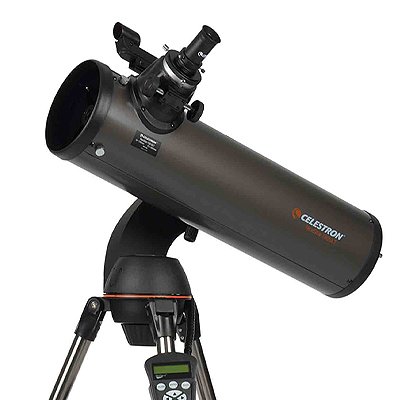
As a first experience using a computerized reflector telescope with an Altazimuth GoTo Mount, we were blown away.
It is so much easier, faster, and fun to use. On this Celestron reflector, we used the SkyAlign function to simply input the date, time, and location into the hand control.
Point the scope to any three bright celestial objects in the sky, and we were set to go.
The scope has a 5.1” optical reflecting telescope lens and a focal length of 650mm. It has a Red Dot StarPointer Finderscope and 2 eyepieces, a 25mm, and a 9mm. We were able to see our Solar System and beyond.
We viewed Saturn’s rings, the Moon’s craters, and Jupiter’s cloud bands. The compact and portable reflector telescope also includes an adjustable, full-height steel tripod, which was ideal for the kids and my taller husband.
Also included is an accessory tray to keep all the bits and pieces close at hand. With a database of more than 40,000 stars, galaxies, nebulae, clusters, and planets, the family was set for years of viewing.
What we liked
- Computerized Altazimuth GoTo mount
- 5.1” aperture for awe-inspiring views
- 2 eyepieces, a 25mm and a 9mm
- Full full-height adjustable steel tripod
- StarPointer Finderscope for easy alignment
- Internal battery compartment prevents cord wrap
- Database of more than 40,000 celestial objects
What we didn’t like
- Computerized technology may not suit everyone
- Higher price for beginners
Type: Newtonian Reflector Telescope
Aperture: 5.1” (130mm)
Focal length: 650mm
Focal ratio: f/5
Mount type: Computerized Altazimuth GoTo
Weight: 18 lbs (8.16 kg)
What’s special about it: Computerized GoTo mount, adjustable full-height steel tripod
Best for: Serious beginners to intermediates, great family hobby
6. Sky-Watcher 8″ Collapsible Dobsonian Telescope
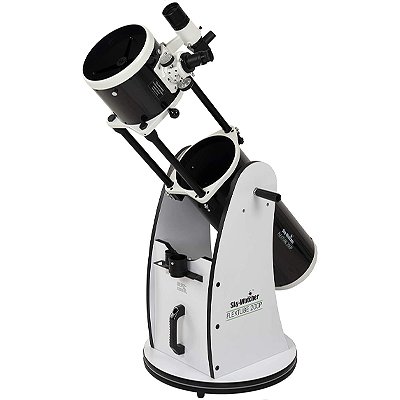
Sky Watcher 8” Dobsonian wide aperture and its long focal length can sometimes be excellent for every backyard astronomer.
The performance should be enough for most of the Messier catalog and similar deep sky objects.
Telescopes with collapsible tubes are really nice for portability; unfortunately, the rocker base is not designed to be disassembled into smaller pieces.
I was surprised that the focuser wasn’t dual speed for fine-tuning.
If you put larger and heavier eyepiece, the scope might lose balance, but my recommendation is to remove the viewfinder and use the lightweight red dot that’s better for pointing the scope and fixes the large eyepiece issue.
This telescope has great value, despite having some drawbacks. I wouldn’d use the included low-grade eyepieces, but that is quickly fixable if you order the cheap aspherical eyepieces, or something better is highly recommended for this nice optics scope.
20 years ago, I would love to have had a Dob like this to start with.
What we liked
- Nice 8” aperture
- Ease of use
- Collapsible, compact tube
- Nice 8×50 viewfinder
- Nice long focal length
- Great value telescope
- Easy to assemble
- Teflon rocker mount bearings
What we didn’t like
- No fine-tuning focuser
- Very rocker base
- Tube balancing
- Low-quality eyepieces
- Heavy for its size
Type: Collapsible Dobsonian reflecting telescope
Aperture: 8”
Focal length: 1200 mm
Focal ratio: f/6
Limiting stellar magnitude: 14.2
Weight: 53 lbs. (24 kg)
What’s special about it: Great for beginners, semi-compact, quite powerful.
7. Orion StarBlast II 4.5 Equatorial Reflector Telescope
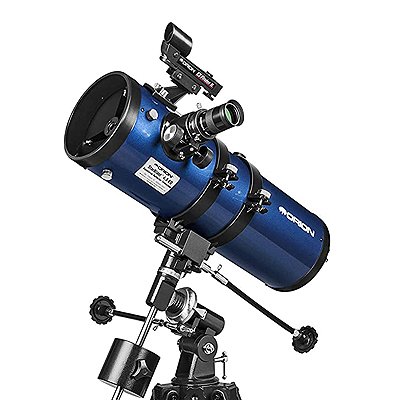
For a family wanting a new hobby that is fun for all ages, the Orion StarBlast II 4.5 Equatorial Reflector Telescope is a great buy.
It is well priced and goes beyond a beginner telescope – offering an opportunity to use it for years to come.
The telescope features a 4.5” aperture, which gives clear, bright images of celestial objects.
We were able to view the Moon and planets like Jupiter, Saturn, and Mars. We also enjoyed viewing distant galaxies and star clusters.
The telescope comes with an EQ-1 mount, which has easy-to-use slow-motion controls. We found that it was very simple to keep the focus on a moving object without it straying all over the eyepiece.
There are 2 Sirius Plossl eyepieces included in the kit. The 25mm eyepiece provides a larger, less magnified window of the night sky. The10mm eyepiece gives fabulous detailed views on specific celestial objects that caught our attention.
The cheap reflector telescope is portable and has an adjustable tripod, ideal for setting up for our small children.
What we liked
- Well priced
- 4.5” aperture for bright views
- 2 eyepieces – 25mm and 10mm Sirius Plossl
- Great for viewing the Moon, planets and star clusters
- Portable and easy to move around
- Slow-motion controls for ease of use
- Adjustable tripod
What we didn’t like
- May be too simple for professionals
- Not motorized
- Manual may be tricky for first-time users to understand
Type: Parabolic Reflector telescope
Aperture: 4.5”
Focal length: 450mm
Focal ratio: f/4
Mount type: Equatorial EQ-1
Weight: 20.7 lbs. (9.4 kg)
What’s special about it: Well priced, comes with 2 eyepieces
Best for: Beginners, as a family hobby
8. Celestron AstroMaster 130 EQ Equatorial Reflector Telescope
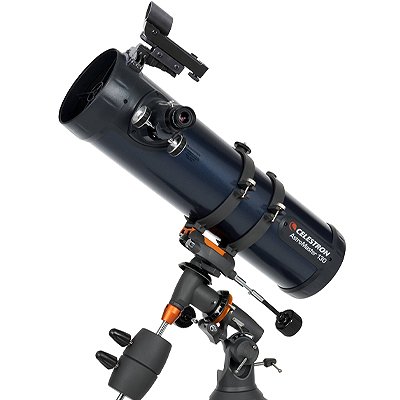
When doing a reflector telescope review on the Celestron AstroMaster 130 EQ Equatorial Reflector Telescope, we found that it comes with two great perks.
One, use it for both terrestrial and celestial viewing. Two, the tripod is pre-assembled, making it easy for people like me who are really bad at DIY projects.
The night time reflector scope features an all-coated glass 130mm mirror, which gives clear, crisp images.
The AstroMaster mount offers 2 slow-motion control knobs, allowing you to make precise adjustments and keep your object in the eyepiece, without it jumping around.
The frame is lightweight, easy to set up, and gives smooth and accurate pointing. There are 2 eye-pieces, a 20mm and a 10mm with a 50x and 100x magnification. To make viewing even easier, there is a StarPointer and a Red Dot Finderscope,
The family enjoyed observing the moons of Jupiter, the rings of Saturn, star clusters, and nebulae. My hubby loves anything nautical, and he had a blast watching ships on the horizon.
For beginners, we found the “The Sky” Level 1 planetarium software with 10,000 object database to be very helpful.
What we liked
- Well priced – good value
- 5.12” aperture for bright views
- Ideal for terrestrial and astronomical use
- All coated glass optics for crisp images
- Deluxe accessory tray
- Comes with “The Sky” Level 1 planetarium software with 10,000 object database
What we didn’t like
- Details aren’t made from premium materials
Type: Reflector
Aperture: 5.12” (130mm)
Focal length: 650mm
Focal ratio: f/5
Mount type: Equatorial
Weight: 24 lbs. (10.89 kg)
What’s special about it: Easy to transport, comes with tripod and planetarium software
Best for: Beginners to intermediates, great family hobby
9. Meade Polaris 130mm German Equatorial Reflector Telescope
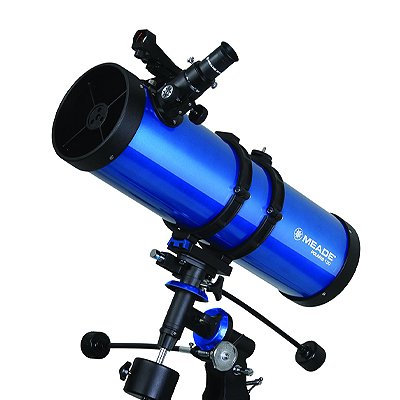
The next telescope we reviewed was the Meade Polaris 130mm Telescope. Made with German precision.
It wowed with clear, crisp views of the night sky. This reflector telescope for sale is ideal for beginner to intermediate stargazers and will last for years.
We enjoyed the very stable Equatorial mount with slow-motion controls.
It allows you to keep an object in view very easily without it jumping around in your eyepiece.
The Meade reflector telescope comes with 3 eyepieces that provide a choice of low (26mm), medium (9mm), and a high (6,3mm) powered magnification. We successfully viewed craters on the Moon and observed planets and star clusters.
The scope is easy to use with a Red Dot Viewfinder helps you point directly at objects you want to observe. The reflector telescope kit included an accessory tray to store your accessories while observing.
To add to the excitement, it comes with a Bonus Autostar Suite Astronomy planetarium DVD, which offers over 10,000 celestial objects.
What we liked
- Well priced
- 5.1” aperture for bright views
- 3 eyepieces for low. Medium and high magnification
- Great for viewing the Moon, planets and star clusters
- Portable and easy to move around
- Slow-motion controls for ease of use
- Bonus Autostar Suite Astronomy planetarium DVD
What we didn’t like
- Not motorized
- Read the Manual slowly and carefully if you are a beginner
Type: Equatorial Reflector telescope
Aperture: 5.1” (130mm)
Focal length: 650mm
Focal ratio: f/5
Mount type: Equatorial mount
Weight: 26.80 lbs (12.2kg)
What’s special about it: Stable Equatorial mount, 3 eyepieces
Best for: Beginners and intermediate stargazers
10. Orion StarBlast 6 Astro Reflector Telescope
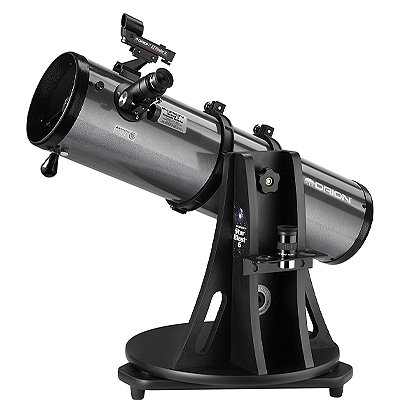
Orion Starblast 6 was the first scope and best reflector we reviewed that has an Altazimuth mount.
This mount allows you to move the telescope both up and down, and sideways.
It also has a compact table-top design, offering a new experience and I must say, a lot more ease-of-use.
It arrived pre-assembled – a bonus for people who are not great at DIY.
This is a 150mm reflector telescope, larger than the previous models we looked at. It is versatile and super easy to use. Weighing in at only 23.5 lbs, we found it was a breeze to take along on the weekend into the country for some serious stargazing.
The Orion reflector telescope comes with two eyepieces – a 25mm and a 10mm Sirius Plossl 1.25″. It also includes an EZ Finder II aiming device, eyepiece rack, and Starry Night Software.
We were able to get amazing detailed views of planets and the Moon, as well as bright deep-sky objects such as nebulas, far-away galaxies, and picturesque open star clusters. This 6 inch reflecting telescope is a great model for serious beginners to intermediates and will offer years of great star-gazing.
What we liked
- Compact table-top design
- Lightweight for easy portability
- 6 inch reflector telescope for awe-inspiring views
- 2 eyepieces, 25mm and 10mm Sirius Plossl 1.25″
- Pre-assembled
- Altazimuth mount
- EZ Finder II aiming device, eyepiece rack, Starry Night Software
What we didn’t like
- Table-top mount not ideal for out-in-country viewing
- Some users complained that the EZ Finder II aiming device did not work
- Professionals may want sharper views
Type: Reflector Telescope
Aperture: 6” (150mm)
Focal length: 750mm
Focal ratio: f/5
Mount type: Altazimuth
Weight: 25 lbs. (11.3 kg)
What’s special about it: Table top mount, lightweight and portable
Best for: Serious beginners to intermediates, great family hobby
11. Orion 10023 SkyQuest XX12i IntelliScope Truss Dobsonian Telescope
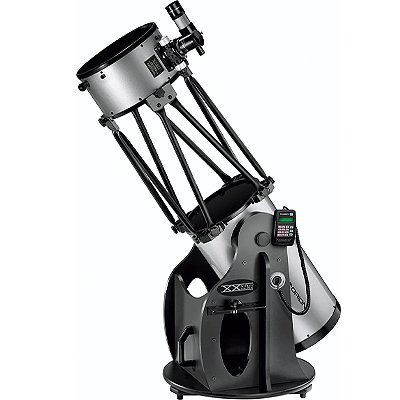
I’m not a great fan of GoTo and Push-To systems; I enjoy star hopping. Push-To system can be very helpful for beginners to quickly find all those nice deep sky objects.
In order to use the Push-To system, you need to set up the IntelliScope system with a vertical position and 2-star alignment; after that, the system is all set up, and the hand controller will guide you to the location of the desired object.
If you want to view the planets, you’ll need to enter the correct date and time as well.
I love the disassembling rocker base; compact Dobsonians are probably the best reflecting telescopes out there. This is a much more compact version of a Dobsonian reflecting telescope than the previously mentioned Sky-Watcher scopes.
First of all, the tube disassembles into three segments, one where the primary mirror is, one segment with the secondary mirror, and truss poles as the third part. The rocker base (mount) disassembles into smaller parts as well without the requirement for any tools.
Even with this scope, there are two eyepieces in the box. The first one is a 10 mm Plossl, which is complete nonsense and the 35 mm, 2” Plossl is somewhat useful for larger DSO, but you won’t get much of a contrast with it.
That’s why I would recommend buying at least the cheap aspherical eyepieces for start, and later you should definitely buy one high-end eyepiece between 10 mm and 25 mm with an ultra-wide apparent field of view at around 100°. That coupled with a nice set of narrowband filters, your Orion scope will be all you’ll ever need for occasional stargazing.
What we liked
- Nice and smooth alt-azimuth movement (panning and tilting)
- Very large 12” aperture
- Free Starry Night software
- Real DSO hunter
- High contrast for DSO
- Long focal length
- Very compact scope and base
- Great portability
- 14,000 DSO database
- Fine-tune dual-speed (11:1) focuser
- Amazing overall performance
- 9×50 finderscope
- Cooling fan
What we didn’t like
- Price
- Longer time for full assembly
- Eyepieces with low-quality optics
- Heavyweight scope
- Need batteries for the hand controller
Type: IntelliScope (Push-To) Truss Dobsonian Telescope
Aperture: 12”
Focal length: 1500 mm
Focal ratio: f/5
Limiting stellar magnitude: 15.1
Weight: 83 lbs. (38 kg)
What’s special about it: Very compact when disassembled, great portability, very powerful telescope, great for DSO hunting.
12. Orion 8968 SkyQuest XX16g GoTo Truss Tube Dobsonian Telescope
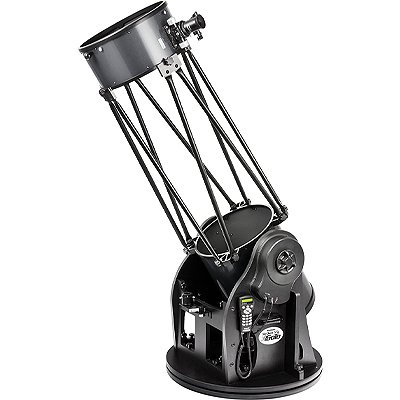
With this colossal Skyquest XX16g Dobsonian, you’ll be the fun center for star parties and astronomy camps.
Excellent piece of hardware, a really large aperture, and great focal length sometimes can be too big.
I’m sure if you are considering this scope, your love for astronomy is bigger than its aperture.
You should be prepared to lift heavy weights or always have a helping hand next to you for transport and assembly.
The secondary mirror is very heavy and very bulky to transport. If you are doing it alone, full unpacking and assembly could take up to 20 min. When pointed at zenith, the eyepiece is at 72 in. (182 cm) from the ground, that means some of you’ll need small steps in order to get to the eyepiece.
The full GoTo motorized base makes this scope very unique in features and capabilities. In the beginning, you should set up the system by aligning with 2 stars and enter the current date and time. After alignment, you can use it as a GoTo system or regular Dobsonian by moving it manually.
Luckily for this scope, there is a ‘closed-loop’ system that detects the manual movement of the scope, so you never lose alignment. There are very useful tension adjustments for nice and smooth manual panning and lifting.
What we liked
- Mammoth 16” mirror
- 4x more light than 8” telescope
- Amazing for DSO and planets
- 8 trusses for rigidness
- Full GoTo functionality
- Closed-loop system for manual use
- 42,000 object in the database
- Base breaks in 4 sections for better transport
- Alt-az tension adjustments
- Very compact scope and base
- Designed for maximum portability
What we didn’t like
- 2x more expensive than regular 16” Dobsonian
- 15-20 min. to full unpacking and assembly
- Cloth shroud not included
- 12V battery not included
- Caring cases not included
- Very heavy system
Type: GoTo Truss Tube Dobsonian Telescope
Aperture: 16”
Focal length: 1800 mm
Focal ratio: f/4.4
Limiting stellar magnitude: 15.7
Weight: 174.0 lbs. (79 kg)
What’s special about it: Very compact when disassembled, great portability for that telescope size, extremely powerful telescope, made for DSO observing.
Also read:
- 5 Best Schmidt Cassegrain Telescopes Worth the Money (2020)
- 5 Best Solar Telescopes in 2020 [to Observe The Sun]
- 5 Best Maksutov-Cassegrain Telescopes Worth the Money (2020)
- 5 Best Astronomy Laser Pointers in 2020 [Green & Blue]
Reflector vs. Refractor
Here are the differences between refractor vs reflector telescopes.
Reflector Telescope
Reflector telescopes have a construction composed of mirrors. These large mirrors offer better light collecting capacity. There are no chromatic aberrations and no colored fringes around stars when viewing.
Different types of reflector telescopes are great for viewing deep-sky objects like galaxies and star clusters. The design of reflector telescopes results in a relatively low-cost telescope for home users.
On the con side, the optical quality can sometimes be disappointing. The mirrors require cleaning processes for best viewing. The open tube design may be affected by dust and humidity. In general, they are bulkier and heavier than refractors.
Refractor Telescope
These telescopes have a design made only of lenses, resulting in a lighter and more transportable telescope.
Refractor telescopes are great for observing the planets and the moon, offering amazing contrast and sharpness.
The closed tube offers protection against humidity and dust and there is almost no maintenance or cleaning needed.
On the con side, there may be chromatic aberrations on the images. Refractor telescopes are usually more expensive than reflector telescopes.
For Who Each is Best For?
When deciding on reflector vs refractor telescopes – reflector telescopes are better suited to beginners and intermediate stargazers.
They are better priced and offer great views of the Moon, planets, and other celestial bodies like galaxies and star clusters.
Refractor scopes are more suited to intermediate to professional viewers as they fall into the higher price range.
They have a more stable optical quality and need fewer adjustments from the observer.
Reflectors Offer the Most Value for Money
Reflectors should be the first telescopes that you get acquainted with. For visual observing the night skies, these should be your only option. Their low price, their large aperture, long focal length and a wider field of view are perfect for amateur astronomers.
In the past several years, there was a significant price drop of the reflecting telescopes, especially the large aperture Dobsonians – the best reflector telescopes became more affordable to the broader public, and with that, astronomy became a lot more popular.
Dobsonian reflecting telescope will give you the best bang for your buck. You can find a nice 6” Dobsonian with a rocker base for under $300, and the respectable 12” can be under $1,000. That nice piece of optics coupled with less than a $100 spent for mid-range eyepieces and filters you can be set even for more advanced stargazing.
What Can You See With a Reflector Telescope?
Moon
Reflectors are meant to observe almost anything. You can start with the Moon and its craters, but bear in mind if you have a larger aperture than 5 or 6 inches, you should use stronger ND filter to dim moonlight, too much brightness can be annoying. Maybe you should use ND filters with the planets too if your scope is larger than 14”.
Planets
Planets are also a joy to look at with this kind of scope, mostly because reflectors don’t suffer from chromatic aberration. If you notice any chromatic aberration, it might be from your low-grade eyepiece or from the atmosphere at low altitudes from the horizon. Double stars and star clusters are also very nice to observe with reflectors, particularly with longer focal length telescopes.
Deep Sky Objects (DSO)
And finally, the deep sky objects (DSO) like nebulae, galaxies, star clusters, comets, that’s what they are constructed for. It’s a pure joy hunting the DSOs with a large Dobsonian. Larger aperture Dobsonian will help you observe everything from the Messier catalog to large chunks of NGC and IC catalogs. Some periodic and nonperiodic comets can be an easy target with your 12” Dob.
Astrophotography
Reflectors, in combination with a motorized equatorial mount, can be used quite successfully for astrophotography, just not for the best of it. There are prominent diffraction spikes from the spider that holds the secondary mirror.
If you use exposures from several nights, the spikes will multiply because of the slightly different scope orientation. If longer exposures are used of brighter stars around the object, the spikes will saturate the image.
I would encourage you to try astrophotography with a reflector, although a refractor is always a better choice for astrophotography.
Maintenance
Most of the Dobsonian reflectors require collimation before every use. Other non-collapsible tube scopes aren’t prone to mirror skew. I would strongly suggest you buy a laser collimator; they are very cheap, they are easy to use and speed up the collimation process. You should have the custom to collimate your Dob before every use, it takes just a couple of minutes to properly collimate both of the mirrors to make sure they are aligned, and your viewing quality is as it should be.
With almost all telescopes, you aren’t going to lose the collimation, but please check before every stargazing session. If your Dobsonian loses the collimation during one night of usage, you should check the construction of the truss poles, tighten the screws, check the spider of the secondary mirror and the cell where the primary mirror is embedded.
Reflectors are quite easy for maintenance. Just dust off the primary and secondary mirror, and that’s about it. Some are saying that because of their ‘open’ design, you should dust and clean them regularly, but in my experience, a bit more dust won’t impede the viewing quality at all. If you happen to be observing at a very dusty location, then very, very softly dust off the mirrors every now and then.
After 3 to 5 years of moderate use, you can wash the mirrors properly with water and soap after dismantling them from the tube. Or maybe you shouldn’t even wash them. These are a heavy-duty, very durable, and tough piece of engineering, just don’t put too much dust on them. Also, the aluminized surfaces of a reflector’s mirrors may need to be sent off for recoating every 20 years or so, more frequently if you live in a high humidity environment, near the sea or badly air-polluted urban area.
The Reflector Telescope Price Range
Starter – up to $150 – Please don’t underestimate this small ‘starter’ reflecting telescopes. If they are small doesn’t mean they are incapable. I’m sure 5” aperture can’t compete with 12” Dobs, but make no mistake they are great for the Moon, the planets and some of the brightest deep-sky objects. These scopes can do what the larger ones can’t, like get the entire Andromeda galaxy or all the Pleiades in your view with a lot of stars around them.
Bargain – $250 to $350 – This is where most of the exploration may begin. This is where every backyard astronomer should start to learn about the night sky, constellations, and star hopping. Most of the Dobs you buy at this price range, you can use them years later, these are always going to be great for the craters on the Moon and the planets.
Budget – $400 to $500 – This is the fun range, not too expensive, not too small. Mid-range scopes are a bit ‘complicated.’ They are nice and better than most people had at the beginning, but you’ll need to spend a lot more money in order to get a meaningful improvement over 8” aperture. And if you start here, you are never going to use these scopes later when you purchase larger ones.
Advanced – $800 to $1100 – My favorite place for shopping. When I bought my 18” Dob, I never knew how much more I’m going to use the compact and lightweight 12” Dob. Why? Because it’s a lot lighter, compact enough to get in the trunk, and have your backseats free for more friends to come along. Most of you will end here, and that’s fine. More powerful scopes you can find at star parties and astronomy camps.
Pro – $2000 to $3500 – Somebody is calling himself a ‘Pro,’ a pro-observer. Well… that can be true if you really love stargazing and you want to observe the faintest details of most of the nebulae in the sky. You can choose whether to opt for 16” with GoTo motorized base or an 18” super compact and lightweight Goliath.
Alien – $6000+ – If you really love this thing, while approaching singularity, astronomy is your real passion. All the family members abandoned you; then, I presume if you have the budget, you’ll spend it on your perfect hyper-scope.
You are going to break through the final frontier; you spent ten grand to see the cosmos as only a few of us have seen it. Accompanied by the greatest, sharpest, and widest apparent field of view eyepieces, you couldn’t get a better view of the stars even from the starship Enterprise.
How to Choose the Right Reflector Telescope?
Call your accountant to estimate your budget for astronomy and spend it all. That’s your perfect scope, for now. But bear in mind that for astronomy there is nothing too big either too small, so choose wisely.
There are several things you should take into consideration, the performance of the scope and the portability.
- Aperture – reflector telescopes are the largest ones for astronomy enthusiasts. If you use your scope for visual observing only, this is the most important detail for the best performance. With wider aperture, you’ll get more light, with that more contrast, and more details you’ll be able to observe.
- Focal length – the longer the focal length of your scope is, the higher magnification you’ll get, the sharper the view will be.
- Field of view – this depends on the eyepieces you use. Their apparent field of view and focal length will give you the true field of view of the telescope.
- Mount – Dobsonian telescopes use rocker bases that are very cheap but very practical. Some rocker boxes can be better and a lot smoother than others because of the materials used. If you choose to have a smaller reflector with an equatorial mount than you can choose between manual or motorized mounts.
- Portability and weight – When you are buying bigger scopes, you must think of portability. This doesn’t affect the viewing quality but can affect your willingness to go out and use it. That’s why sometimes you should pay 20 to 30 percent more for a more compact Dobsonian reflector telescope.
FAQ
What is the best reflector telescope?
The Orion Starblast ii 4.5 equatorial reflector telescope is the best reflector telescope. It features a 4.5” aperture for clear images and an EQ-1 mount with slow-motion controls.
Are reflector telescopes any good?
Reflector telescopes are great for viewing deep-sky objects like galaxies and star clusters. They are ideal for home users who want to start stargazing as a hobby.
Should I buy refractor or reflector telescope?
Reflector or refractor? Decide on your needs and budget. Refractors are usually more expensive but require less maintenance. Reflecting telescopes are popular because they’re cheaper and ideal for beginners.
Do astronomers use reflecting or refracting telescopes?
Professional astronomers use a range of high-tech telescopes for achieving views with exceptional details. These include reflective telescopes, radio telescopes, ultraviolet, infrared, optical, X-ray, and gamma-ray telescopes.
What does a reflector telescope do?
Reflector telescopes gather light through two glass mirrors and transmit the image to the eyepiece. The design offers a high-quality image with few distortions or aberrations.
Can you see planets with a reflector telescope?
Yes, you can see planets with a reflector telescope. Enjoy seeing the moons of Jupiter, the rings of Saturn, and the reddish tinge of Mars.

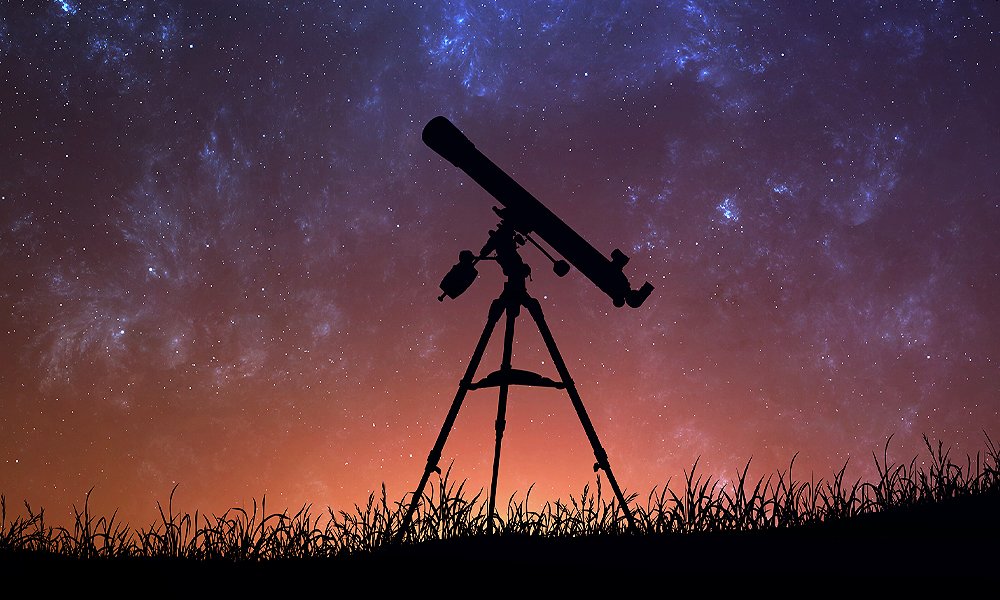


![10 Best Telescopes Under 0 [in 2024]](https://www.planetguide.net/wp-content/uploads/2020/06/Depositphotos_273495332_s-2019-768x499.jpg)
![5 Best Solar Telescopes in 2024 [to Observe The Sun]](https://www.planetguide.net/wp-content/uploads/2020/01/solar-telescope-768x461.jpg)
![12 Best Beginner Telescopes in 2024 [Actually Simple to Use]](https://www.planetguide.net/wp-content/uploads/2020/06/rfe-768x488.jpg)
